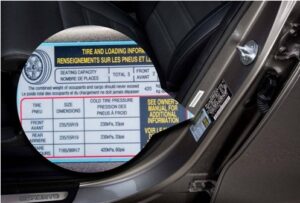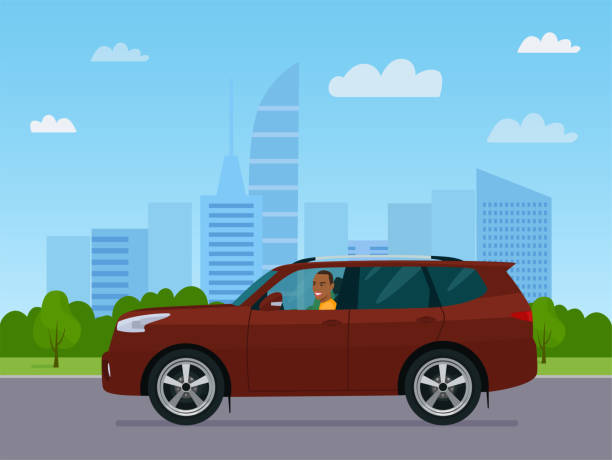Tire pressure is one of the most vital components of a tire, no matter the type of vehicle they’re attached to. If you’re not doing it already, it’s important you check your tire pressure every two weeks. The right tire pressure ensures optimal traction and grip on any terrain and gives you more mileage for your fuel.
Let’s get into detail and discuss how to find the correct tire pressure for your SUV and the things you need to consider when it comes to monitoring tire pressure.
- Tire pressure varies – it depends on the size, load and type of tires
- Check your tire pressure every two weeks
- Find your vehicle’s recommended tire pressure on the door frames of the passenger and driver’s side, fuel filler door and the vehicle’s manufacturer’s handbook
- Check your air pressure even if you have a tire pressure monitoring system
If there’s no sticker on the door, you can usually find the specs in the owner’s manual. Most passenger cars will recommend 32 psi to 35 psi in the tires when they’re cold. According to experts, 40 psi is the perfect number to balance the vehicle’s weight through research. Of course, pickups or SUVs often need a more significant number, but the difference is insignificant.
What should the air pressure be for my SUV tires?
Unfortunately, there’s no universal bar specification that matches every tire. However, for a general example, if you have an SUV with a relatively low load, the number will be around 2,4 bar.
There are several things to consider when adjusting your air pressure. If you drive your on-road SUV or CUV primarily on asphalt roads – and are not doing anything unusual on your drive such as carrying a heavy load or driving for a very long time – there are some quick handy places to check what your tire pressure should be:
- On the door frames of the passenger and driver’s side
- On the fuel filler door
However, if you are carrying a heavy load and are going on a long car trip, you should always refer to:
If there’s no sticker on the door, you can usually find the specs in the owner’s manual. Most passenger cars will recommend 32 psi to 35 psi in the tires when they’re cold. According to experts, 40 psi is the perfect number to balance the vehicle’s weight through research. Of course, pickups or SUVs often need a more significant number, but the difference is insignificant.
Your vehicle’s manufacturer’s handbook (see below).

It will detail the recommended pressure for the front and rear tires of your particular vehicle. This is the minimum amount of air pressure needed in cold tires to support your vehicle. You’ll probably see two figures, one for normal use and one for full loads. If you’re still unsure, always check with your local tire professional.
Infographic demonstrating where to find the recommended air pressure for tires
Know where to find your tire pressure
Air pressure for Four Wheel Drive (4WD) tires
You will also find the recommended air pressure for 4WD tires in your SUV manufacturer’s handbook, vehicle door frames and the fuel filler door – the same as for any other vehicle. However, it’s common to lower the tire pressure when you’re off-roading. This is done to reduce the bouncing on uneven terrain and to also increase the tire contact area over soft or uneven ground. This helps reduce rolling resistance while increasing grip and, overall, reduces the chances of a puncture. However, with lower air pressure, you can’t drive as fast due to the heat buildup in tires.
What if I have a tire pressure monitoring system?
If you have a 2008 or newer SUV, it will probably have a tire pressure monitoring system (TPMS). In many countries, these are already mandatory and most new cars come equipped with them as standard. The sensors continuously monitor tire pressure and will alarm you with a dashboard symbol when pressure is dangerously low.
When the TPMS light illuminates, you need to check the pressure of all four tires. Only one might need air, but it’s important to do a thorough check. The TPMS light will also flash if you’re using a spare tire and the vehicle cannot detect the sensor of the original wheel. If you’ve checked all tires and can’t find anything wrong, there could be a malfunction with the TPMS system.
While the TPMS system is a great way to warn you of a puncture, it’s still your responsibility to check your tires and be aware of their condition, so you can react in advance to issues like uneven wear or dangerously low tread.
Tips for checking tire pressure
As a general rule, aim to check your tire pressure every two weeks and every time you set off for a long trip or are carrying a heavy load.
Make sure your tires are cold.
You’ll get a more accurate reading if you check the pressure first thing in the morning when they haven’t been used or haven’t been in the direct sunlight for too long.
Always use the handbook.
When in doubt, refer to the vehicle’s manufacturer’s handbook. It will specify the minimum amount of air pressure needed in cold tires to support your vehicle.
Use a reliable gauge and air compressor.
You can buy one from an auto store or use one free of charge at a petrol station.
Check the pressure properly.
Place the gauge onto the valve stem and press down firmly until the hissing sound of air escaping stops. The gauge will show a reading of the pressure, make sure it matches the manufacturer’s recommendation. If it’s too high, push the valve to let out some air. If the air pressure is too low, attach the air compressor to the valve and fill the tire until it reaches the recommended level.







